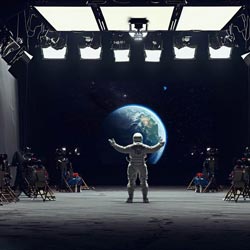 In the shadowy realm of human history, few events have stirred the collective imagination as profoundly as the purported landing of mankind on the moon's desolate surface. Yet, amidst the jubilation and awe, a sinister theory took root, whispering of deceit and illusion. This essay dares to tread the spectral corridors of the Moon Landing Hoax theory, a grand charade suggesting a cosmic pantomime staged to declare victory in the Space Race. Let's venture into the origins of this eldritch theory, shedding light on the conditions that gave birth to such a belief.
In the shadowy realm of human history, few events have stirred the collective imagination as profoundly as the purported landing of mankind on the moon's desolate surface. Yet, amidst the jubilation and awe, a sinister theory took root, whispering of deceit and illusion. This essay dares to tread the spectral corridors of the Moon Landing Hoax theory, a grand charade suggesting a cosmic pantomime staged to declare victory in the Space Race. Let's venture into the origins of this eldritch theory, shedding light on the conditions that gave birth to such a belief.
Meet the champions of this theory, those who dared to question the official narrative and present their own interpretation of the events. I delve into the evidence they present, dissecting their claims and arguments. Finally, I present the scholarly rebuttals that seek to dispel the darkness, shining the light of reason and logic on the shadowy corners of the Moon Landing Hoax theory. Thus, we embark on a journey into the heart of one of the most captivating conspiracy theories in human history, a journey that takes us to the very edge of truth and illusion.
Introduction
In the annals of human history, inscribed in the indelible ink of time, few events have stirred the collective imagination as profoundly as the purported landing of mankind on the moon's desolate surface. This monumental event, orchestrated by the United States' National Aeronautics and Space Administration (NASA) on July 20, 1969, was a beacon of human achievement, a testament to our capacity to reach out into the cosmic abyss. Yet, amidst the jubilation and awe, a sinister theory took root, whispering of deceit and illusion. This theory, known as the Moon Landing Hoax, suggests a grand charade, a cosmic pantomime staged to declare victory in the Space Race against the formidable Soviet Union.
The Moon Landing Hoax, like a spectral wraith emerging from the ether, whispers of a grand deception. It claims that some or all elements of the Apollo program and the associated Moon landings were hoaxes staged by NASA, possibly with the aid of other organizations. The most notable claim is that the six crewed landings (1969–1972) were faked and that twelve Apollo astronauts did not actually walk on the Moon. Various groups and individuals, like arcane scholars poring over cryptic texts, have made claims since the mid-1970s that NASA and others knowingly misled the public into believing the landings happened, by manufacturing, tampering with, or destroying evidence including photos, telemetry tapes, radio and TV transmissions, and Moon rock samples.
This essay shall dare to tread the shadowy corridors of this theory, venturing into the labyrinth of doubt and suspicion. It will explore the origins of the Moon Landing Hoax, shedding light on the conditions that gave birth to such a theory. It will introduce the champions of this theory, those who dared to question the official narrative and present their own interpretation of the events. It will delve into the evidence they present, dissecting their claims and arguments. Finally, it will present the scholarly rebuttals that seek to dispel the darkness, shining the light of reason and logic on the shadowy corners of the Moon Landing Hoax theory. Thus, we embark on this journey, a journey into the heart of one of the most captivating conspiracy theories in human history.
The Genesis of the Deception
In the early 1970s, a mere cosmic blink after the Apollo 11 mission, the Moon Landing Hoax began to materialize, much like a spectral wraith emerging from the ether. The first to voice their doubts were a select few, their minds akin to the keen-eyed raven, dissecting the moon landing footage and photographs with a suspicious gaze. Their voices, though few, echoed in the minds of many, sowing seeds of doubt that would soon grow into a forest of disbelief, a labyrinth of questions shrouded in the mist of uncertainty.
The era itself was a fertile ground for such seeds of skepticism. The Cold War, a silent, ominous specter, cast long shadows over the world, and the government's credibility was tarnished by scandals like Watergate. In this climate of suspicion and fear, the notion of a faked moon landing found fertile soil, growing and spreading like a dark, insidious vine. The whispers of deceit were carried on the winds of mistrust, and the seeds of doubt took root in the minds of the public.
As the years passed, the vine of disbelief grew stronger, its tendrils reaching out, wrapping around the pillars of truth and reality. The theory was further fueled by the writings of Bill Kaysing, a former naval officer, whose tome, "We Never Went to the Moon: America's Thirty Billion Dollar Swindle," became a beacon for those who dared to question the lunar landing. The Flat Earth Society, too, joined the chorus of doubt, accusing NASA of staging the landings with the aid of Hollywood and the sponsorship of Walt Disney. These voices, though disparate, sang a haunting melody of doubt and deception, a song that resonated with those disillusioned by the era's political climate and a general mistrust of authority. Thus, the Moon Landing Hoax, once a spectral wraith, had taken a solid form, casting a long, ominous shadow over one of humanity's greatest achievements.
The Prophets of Deception
Among the apostles of this eldritch theory, Bill Kaysing, a former naval officer, emerged as a prominent figure. His tome, "We Never Went to the Moon: America's Thirty Billion Dollar Swindle," became a sacred text for those who dared to question the lunar landing. This self-published work, released in the year 1976, was a beacon in the darkness for those who sought to challenge the narrative of the Apollo mission. Despite having no knowledge of rockets or technical writing, Kaysing was hired as a senior technical writer in 1956 by Rocketdyne, the company that built the F-1 engines used on the Saturn V rocket. He served as head of the technical publications unit at the company's Propulsion Field Laboratory until 1963. The many allegations in Kaysing's book effectively began the discussion of the Moon landings being faked.
Another disciple of doubt, Bart Sibrel, used the medium of film to propagate his beliefs. His documentary, "A Funny Thing Happened on the Way to the Moon," was a cinematic testament to his skepticism, a celluloid challenge to the official narrative of the Apollo mission. Sibrel's work, like Kaysing's, became a cornerstone for those who questioned the veracity of the moon landing, further fueling the flames of the Moon Landing Hoax theory.
In the year 1980, the Flat Earth Society, a group known for their rejection of the spherical Earth model, accused NASA of faking the landings. They argued that the moon landing was a grand spectacle, staged by Hollywood with Walt Disney sponsorship, based on a script by Arthur C. Clarke and directed by Stanley Kubrick. This claim, though outlandish, added another layer to the growing tapestry of the Moon Landing Hoax theory, further complicating the narrative and adding more fuel to the fire of skepticism.
Folklorist Linda Dégh suggests that writer-director Peter Hyams' film Capricorn One (1978), which shows a hoaxed journey to Mars in a spacecraft that looks identical to the Apollo craft, might have given a boost to the hoax theory's popularity in the post-Vietnam War era. This film, though fiction, resonated with the public's growing mistrust of the government and scientific institutions, further amplifying the echoes of the Moon Landing Hoax theory. Thus, the theory, once a spectral wraith, had taken a solid form, its proponents casting long, ominous shadows over one of humanity's greatest achievements.
The Evidence of the Unseen
The acolytes of the Moon Landing Hoax theory, like arcane scholars poring over cryptic texts, point to a myriad of anomalies in the Apollo mission's visual records. They speak in hushed tones of unnatural lighting, of shadows that defy the laws of physics, of a lunar sky devoid of stars, of a flag that ripples in the vacuum of space, and of footage that seems too crude for the era's technology. These perceived inconsistencies, they argue, are not mere coincidences, but rather telltale signs of a grand deception.
They question, too, the silence that has followed, the absence of further lunar expeditions. This silence, they argue, is not the quiet of accomplishment, but rather the hush of a secret kept. The cessation of lunar missions, they claim, is not due to a lack of interest or resources, but rather an attempt to avoid further scrutiny, to prevent the unraveling of a carefully woven tapestry of deceit.
Those who believe the Moon landings were faked offer several theories about the motives of NASA and the United States government. The three main theories are the Space Race, NASA funding and prestige, and the Vietnam War. The Space Race, they argue, provided motivation for the United States to engage the Soviet Union in a competition for supremacy in space exploration. Landing on the Moon was viewed as a national and technological accomplishment that would generate worldwide acclaim. But going to the Moon would be risky and expensive, as exemplified by President John F. Kennedy famously stating in a 1962 speech that the United States chose to go because it was hard.
The theory of NASA funding and prestige suggests that NASA faked the landings to avoid humiliation and to ensure that it continued to get funding. NASA raised "about US$30 billion" to go to the Moon, and Kaysing claimed in his book that this could have been used to "pay off" many people. The Vietnam War theory posits that the landings helped the United States government distract public attention from the unpopular Vietnam War, and so crewed landings suddenly ended about the same time that the United States ended its involvement in the war.
Many Moon-landing conspiracy theories have been proposed, alleging that the landings either did not occur and NASA staff lied, or that the landings did occur but not in the way that has been reported. Conspiracists have focused on perceived gaps or inconsistencies in the historical record of the missions. The foremost idea is that the whole crewed landing program was a hoax from start to end. Some claim that the technology to send men to the Moon was lacking or that the Van Allen radiation belts, solar flares, solar wind, coronal mass ejections and cosmic rays made such a trip impossible. These claims, though outlandish, add to the growing chorus of the Moon Landing Hoax theory, further complicating the narrative and adding more fuel to the fire of skepticism.
The Light of Reason
Yet, against this tide of suspicion, scholars and scientists stand firm, their voices a beacon in the darkness, a lighthouse amidst the storm of conspiracy. They argue that the anomalies, the perceived inconsistencies in the Apollo mission's visual records, are not evidence of deceit, but rather misunderstandings of lunar conditions and photographic techniques. The missing stars, they say, are a consequence of the camera's exposure settings, optimized for the moon's bright surface. The stars, though absent in the photographs, were not absent in reality, but merely hidden by the limitations of the camera.
The rippling flag, another point of contention for the proponents of the Moon Landing Hoax theory, is simply the result of its deployment method and the moon's lack of air resistance. The flag, they argue, did not ripple in the wind, for there is no wind on the moon. Instead, it moved due to the momentum imparted by the astronauts as they planted it on the lunar surface. This explanation, grounded in the laws of physics, dispels the shadow of doubt cast by the rippling flag.
The question of further lunar missions is answered with the mundane realities of budgetary constraints and shifting priorities in space exploration. The silence that followed the Apollo missions, they argue, is not the hush of a secret kept, but rather the quiet of a chapter closed. The focus of space exploration shifted from the moon to other celestial bodies and to the construction and maintenance of space stations. The cessation of lunar missions, they argue, is not evidence of a hoax, but rather a reflection of changing priorities and limited resources.
They also argue the improbability of maintaining such a grand illusion, given the thousands involved in the Apollo program. A secret of such magnitude, they argue, could not be kept for over half a century. Moreover, the Soviet Union, America's adversary in the Space Race, tracked the Apollo missions and would surely have exposed a deception of such magnitude. The silence of the Soviets, they argue, is not the silence of complicity, but rather the silence of acceptance, an acknowledgement of the reality of the moon landings. Thus, the beacon of reason shines through the darkness of conspiracy, illuminating the path of truth and dispelling the shadows of doubt.
The Nature of Conspiracy Theory
In the shadowy realm of conspiracy theories, the Moon Landing Hoax stands as a monolith, a testament to the human propensity for doubt and mistrust. Drawing from the eldritch tomes of scholarly sources, we can delve deeper into the psychology and societal impact of such theories, exploring the dark corridors of the human mind and the societal conditions that give birth to such beliefs.
In his paper, "Conspiracy theories in science," Ted Goertzel, like a lone explorer in a dark forest, discusses the far-reaching tendrils of conspiracy theories. He notes that these theories, targeting specific research, can have grave consequences for public health and environmental policies. Like a virulent plague, conspiracy theories are easy to propagate and difficult to refute, and they have begun to gain ground in recent years, striking a chord with a public already mistrustful of science and government. This can be seen in the case of the Moon Landing Hoax, where the seeds of mistrust in government and scientific institutions have found fertile soil, giving rise to a dark tree of disbelief.
In the study, "What about building 7? A social psychological study of online discussion of 9/11 conspiracy theories," Michael Wood and Karen M. Douglas delve into the labyrinthine psychology of conspiracy belief. They found that those who believe in conspiracy theories are more likely to argue against the opposing interpretation and less likely to argue in favor of their own interpretation. This can be seen in the Moon Landing Hoax discussions, where proponents, like ancient necromancers, focus more on debunking the official narrative rather than providing substantial evidence for their own claims.
In "Believing in Conspiracy Theories: Evidence from an Exploratory Analysis of Italian Survey Data," Moreno Mancosu, Salvatore Vassallo, and Cristiano Vezzoni discuss the widespread diffusion of conspiracy theories in Italy. They found that belief in conspiracy theories is negatively associated with education and positively with religiosity. This suggests that educational level and religious beliefs, like twin specters, can play a role in the acceptance of conspiracy theories like the Moon Landing Hoax.
Finally, in "The Age of Post-Truth," James B. Glattfelder discusses the modern post-truth world, a realm infused with ignorance and anti-intellectualism. He notes that conspiracy theories abound in this environment, like grotesque creatures lurking in the shadows. This can be seen in the persistence of the Moon Landing Hoax, a theory that, despite being debunked, continues to haunt the collective consciousness, a ghostly reminder of our propensity for doubt and mistrust.
Conclusion
In the final reckoning, the Moon Landing Hoax theory, like an ancient edifice weathered by the relentless winds of time, crumbles under the weight of scientific scrutiny. Its foundations, built not on the solid bedrock of empirical evidence but rather on the shifting sands of political climate and mistrust of authority, prove to be unstable. The theory, though captivating in its audacity, is ultimately a house of cards, collapsing under the slightest touch of reason and logic.
The moon landing, therefore, stands as a monumental testament to human achievement, a beacon of our potential when we dare to venture into the cosmic abyss. It is a tale of triumph, not of deceit, a story written not in the shadows and illusions of conspiracy, but in the indelible ink of human courage and ingenuity. It is a testament to our ability to reach out into the unknown, to touch the face of the cosmos, and to return, forever changed by the experience.
In the end, the Moon Landing Hoax theory serves as a reminder of our propensity for doubt and mistrust, a reflection of our fears and insecurities. But it also serves as a testament to our capacity for reason and logic, our ability to separate fact from fiction, truth from illusion. The moon landing remains a beacon of truth in a sea of conspiracy, a lighthouse guiding us through the stormy seas of misinformation and doubt. It stands as a testament to our potential, a reminder of what we can achieve when we dare to dream, to explore, to reach for the stars.
Bibliography:
- Goertzel, Ted. "Conspiracy theories in science." EMBO reports 11.7 (2010): 493-499.
- Wood, Michael J., and Karen M. Douglas. "What about building 7? A social psychological study of online discussion of 9/11 conspiracy theories." Frontiers in psychology 4 (2013): 409.
- Mancosu, Moreno, Salvatore Vassallo, and Cristiano Vezzoni. "Believing in Conspiracy Theories: Evidence from an Exploratory Analysis of Italian Survey Data." South European Society and Politics 22.4 (2017): 327-344.
- Glattfelder, James B. "The Age of Post-Truth." Complexity 22.5 (2017): 8-9.
- Kaysing, Bill. "We Never Went to the Moon: America's Thirty Billion Dollar Swindle." (1976).
- Sibrel, Bart. "A Funny Thing Happened on the Way to the Moon." (2001).
- "Moon landing conspiracy theories." Wikipedia, The Free Encyclopedia. Wikimedia Foundation, Inc. Accessed on June 8, 2023.
Further Reading:
- Plait, Phil. "Bad Astronomy: Misconceptions and Misuses Revealed, from Astrology to the Moon Landing 'Hoax'." John Wiley & Sons, 2002.
- McClelland, James. "The Apollo Moon Missions: The Unsung Heroes." Greenwood Publishing Group, 2002.
- Long, Greg. "Making Moon Hoax: Inside the Apollo Legend." CreateSpace Independent Publishing Platform, 2015.
- Loxton, Daniel, and Donald R. Prothero. "Abominable Science: Origins of the Yeti, Nessie, and Other Famous Cryptids." Columbia University Press, 2013.
- Shermer, Michael. "Why People Believe Weird Things: Pseudoscience, Superstition, and Other Confusions of Our Time." Henry Holt and Company, 2002.






